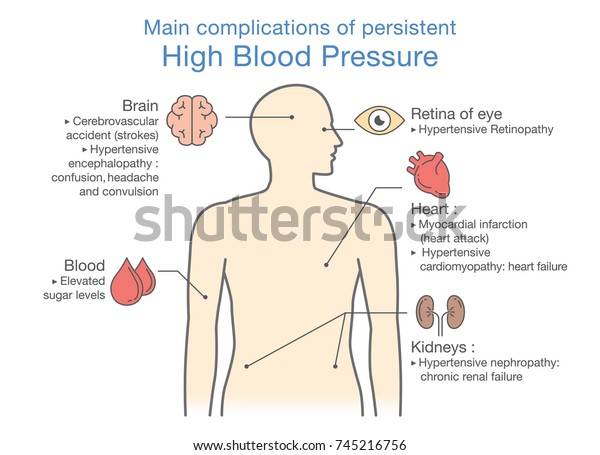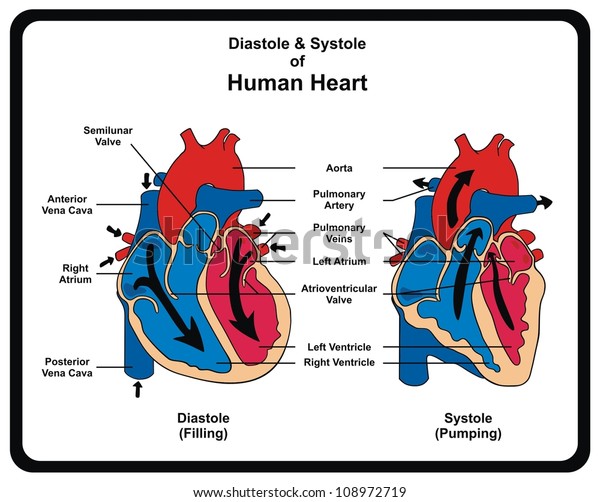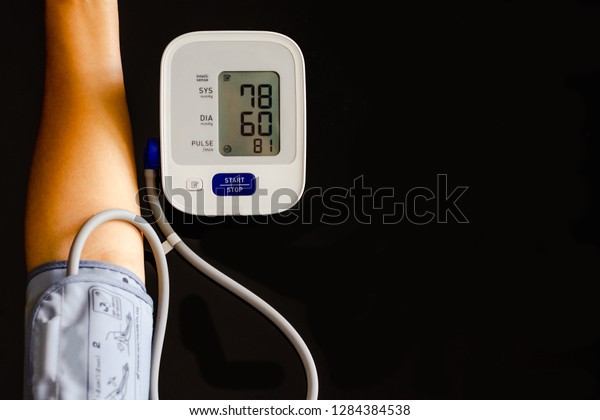High blood pressure is a common condition in individuals in which the long-term force of the blood against artery walls is high enough that it may eventually cause health problems, such as heart disease.
Blood pressure is determined both by the amount of blood that heart pumps and the amount of resistance to blood flow in the arteries. The more blood the heart pumps and the narrower arteries, the higher the blood pressure.
A person can have high blood pressure (hypertension) for years without any symptoms. Even without symptoms, damage to blood vessels and the heart continues and can be detected. Uncontrolled high blood pressure increases risk of serious health problems, including heart attack and stroke.

Causes of Hypertension

The cause of hypertension is often not known. In many cases, it is the result of an underlying condition. Stress can increase the risk of high blood pressure. Doctors call high blood pressure that is not due to another condition or disease primary or essential hypertension. If an underlying condition is the cause of increasing blood pressure, doctors call this secondary hypertension.
Primary hypertension can result from multiple factors, such as:
- hormone activity in people who manage blood volume and pressure using medication
- blood plasma volume
- environmental factors, such as stress and lack of exercise
Secondary hypertension has specific causes and is a complication of another health problem.
Chronic kidney disease is a common cause of high blood pressure, as the kidneys no longer filter out fluid. This excess fluid leads to hypertension.
Conditions that can lead to hypertension include:
- pheochromocytoma, a rare cancer of an adrenal gland
- diabetes, due to kidney problems and nerve damage
- kidney disease
- hyperparathyroidism, which affects calcium and phosphorous levels
- Cushing syndrome that corticosteroid drugs can cause
- sleep apnea
- congenital adrenal hyperplasia, a disorder of the cortisol-secreting adrenal glands
- hyperthyroidism, or an overactive thyroid gland
- pregnancy
- obesity
Risk factors
There are a number of factors that increase the risk of hypertension.
- Age: Hypertension is more common in people who are more than 60 years of age. Blood pressure can increase slowly and steadily with age as the arteries stiffen and narrow due to plaque buildup.
- Ethnicity: Some ethnic groups are more prone to hypertension than others. African Americans have a higher risk than other ethnic groups, for example. Size and weight: Being overweight or obese is a primary risk factor.
- Alcohol and tobacco use: Regularly consuming large quantities of alcohol or tobacco can increase blood pressure.
- Sex: According to a 2018 review, males have a higher risk of developing hypertension than females. However, this is only until after women reach menopause.
- Existing health conditions: Cardiovascular disease, diabetes, chronic kidney disease, and high cholesterol levels can lead to hypertension, especially as people age.
Other risk factors include:
- sedentary lifestyle
- salt rich, high fat diet
- low potassium intake
Poorly managed stress and a family history of high blood pressure can also contribute to the risk of developing hypertension.
How blood pressure and circulatory system works?
In order to survive and function properly, the tissues and organs of a body need the oxygenated blood that circulatory system carries throughout the body. When the heart beats, it creates pressure that pushes blood through a network of tube-shaped blood vessels, which include arteries, veins and capillaries. This pressure, blood pressure, is the result of two forces: The first force is systolic pressure which occurs as blood pumps out of the heart and into the arteries that are part of the circulatory system. The second force is diastolic pressure which is created as the heart rests between heart beats.

When does the damage starts in the arteries and heart?
The primary way that high blood pressure causes harm in the body is by increasing the workload of the heart and blood vessels and making them work ■■■■■■ and less efficiently.
With the time, the force and friction of high blood pressure damages the delicate tissues inside the arteries. In turn, LDL (bad) cholesterol forms plaque along tiny tears in the artery walls, signifying the start of atherosclerosis.
The more the plaque and damage increases, the narrower the insides of the arteries become, raising blood pressure and starting a vicious circle that further harm arteries, heart and the rest of the body. This can ultimately lead to other conditions ranging from arrhythmia to heart attack and stroke.

Stages of Hypertension
Doctors classify blood pressure into four main categories:
1. normal
2. prehypertension (mild)
3. stage 1 (moderate)
4. stage 2 (severe).
Treatment of these stages of hypertension depend on which category blood pressure consistently falls in when readings are taken. The stages are based on the Joint National Committee 7 report done by the National Heart, Lung and Blood Institute, which is a part of the National Institutes of Health.
Here are the current stages and their recommended treatments:
- Normal. In normal stage, systolic pressure should be less than 120 mm Hg and diastolic pressure should be less than 80 mm Hg.
Recommended Treatment
No treatment is necessary, but people should monitor their blood pressure to be sure that it remains within the normal range.
- Prehypertension: In prehypertension stage systolic pressure between 120 and 139 mm Hg or a diastolic pressure between 80 and 89 mm Hg. It is before someone crosses the threshold for the definition of hypertension but is at risk for developing hypertension.
Recommended Treatment
Researchers said that they don’t have evidence that using medications at this range is useful for preventing heart disease and stroke. However, because people in this group have some risk of moving on to developing heart disease, doctors recommend lifestyle measures to try to prevent the onset of hypertension. Lifestyle measures include exercise, managing body weight into a normal range, eating a diet high in fruits and vegetables, and choosing low-fat dairy products.
- Stage 1: Systolic pressure between 140 and 159 mm Hg or diastolic pressure between 90 and 99 mm Hg.
Recommended Treatment
Management includes the same lifestyle measures as with prehypertension and the use of one of a number of drugs that are known to not only reduce blood pressure but also to reduce the risk of heart disease and stroke. Classes of drugs include: thiazide diuretics, ACE inhibitors, angiotensin receptor blockers, beta blockers, and calcium channel blockers. people may have to try different drugs until they find the one that has the best results for them.
- Stage 2: In this stage systolic pressure 160 mm Hg or higher or diastolic pressure 100 mm Hg or higher.
Recommended Treatment
In addition to lifestyle changes, for many patients, it is recommended that a two-drug therapy chosen from among the five classes of hypertensive agents be used to get their blood pressure down.
If the systolic and diastolic pressures fall into different stages, the stage with the higher number is the one that counts. For example, if a person has a systolic pressure of 150 mm Hg but diastolic pressure is only 85 mm Hg, he will be classified as stage 1 hypertension, not prehypertension. And if a person is over age 50, it is the diastolic number that best predicts risk of cardiovascular disease.
If these stages left untreated, high blood pressure can lead to coronary heart disease, which can mean a heart attack or stroke. People should have their blood pressure checked regularly, and follow their doctor’s advice for keeping it under control.

How Blood Pressure is Measured?
Blood pressure is measured with an instrument called a sphygmomanometer, through which the user listens for the sound of the force of blood in the patient’s arteries when the heart beats (systolic pressure). Measured in millimeters of mercury (mm Hg), systolic pressure is the top number in your blood pressure reading. The second, or bottom number, is the pressure in the arteries of the heart at rest, the diastolic pressure. Generally, an adult are considered to have high blood pressure if systolic pressure reading is greater than or equal to 140 mm Hg or if diastolic pressure is greater than or equal to 90 mm Hg. But for every 20 mm Hg systolic pressure raises above 115, and for every 10 mm Hg diastolic pressure rises over 75, risk of cardiovascular disease doubles, so lower pressures are generally better.

The AHA 2017 guidelines have defined the following ranges of blood pressure:
| Systolic (mmHg) | Diastolic (mmHg) | |
|---|---|---|
| Normal blood pressure | Less than 120 | Less than 80 |
| Elevated | Between 120 and 129 | Less than 80 |
| Stage 1 hypertension | Between 130 and 139 | Between 80 and 89 |
| Stage 2 hypertension | At least 140 | At least 90 |
| Hypertensive crisis | Over 180 | Over 120 |
If the reading indicates a hypertensive crisis, wait 3 or 4 minutes and then repeat the test.
If the reading is the same or higher, this indicates that you need a medical emergency.
The person should seek immediate help at the nearest hospital.
Symptoms of Hypertension
A person with hypertension may not notice any symptoms, and so people often call it the “silent killer.” Without detection, hypertension can damage the heart, blood vessels, and other organs, such as the kidneys.
It is important to check blood pressure regularly.
In rare and severe cases, high blood pressure causes sweating, anxiety, sleeping problems, and blushing. However, most people with hypertension will experience no symptoms at all.
If high blood pressure becomes a hypertensive crisis, a person may experience headache and nosebleeds.
Complications
If someone has a long term hypertension, it can cause complication through atherosclerosis where plaque develops on the walls of blood vessels, causing them to narrow.
This narrowing of walls of blood vessels makes hypertension worse, as the heart must pump ■■■■■■ to circulate the blood.
Hypertension-related atherosclerosis may lead to:
- kidney failure
- heart failure and heart attacks
- amputation
- aneurysm, or abnormal bulge in the wall of an artery that can burst
- stroke
- hypertensive retinopathies in the eye, which can lead to blindness
Regular blood pressure monitoring can help people avoid these more severe complications.
Management and treatment of hypertension
Adjustments of lifestyle are the standard, first-line treatment for hypertension. Some of the recommendations are here:
Regular physical exercise
-
Current guidelines recommend that all people, including those with hypertension, should engage in at least 150 minutes of moderate intensity, aerobic exercise every week, or 75 minutes a week of high intensity exercise.
-
People should exercise on at least 5 days of the week.
-
Examples of suitable activities are walking, jogging, cycling, or swimming.
Reduction of Stress
-
People should avoid or learn to manage stress. It can help a person control blood pressure.
-
Meditation, warm baths, yoga and simply going on long walks are relaxation techniques that can help them relieve stress.
-
People should avoid consuming alcohol, recreational drugs, tobacco, and junk food to cope with stress, as these can contribute to elevated blood pressure and the complications of hypertension.
-
Smoking can increase blood pressure. Avoiding or quitting smoking reduces the risk of hypertension, serious heart conditions, and other health issues.
. Medication for Hypertension
People can use medications to treat hypertension. Doctors will often recommend a low dose at first. Antihypertensive medications will usually only have minor side effects.
Eventually, people with hypertension will need to combine two or more drugs to manage their blood pressure.
Medications for hypertension include:
- angiotensin-converting enzyme (ACE) inhibitors
- diuretics, including thiazides, chlorthalidone, and indapamide
- beta-blockers and alpha-blockers
- calcium-channel blockers
- angiotensin receptor blockers
- central agonists
- peripheral adrenergic inhibitor
- vasodilators
The choice of medication depends on the person and any underlying medical conditions they may experience.
Diet
People can prevent themselves from high blood pressure by following a heart-healthy diet.
- By reducing salt intake
People’s average salt intake is between 9 grams (g) and 12 g per day in most countries around the world.
The World Health Organization (WHO) recommend reducing intake to under 5 g a day to help decrease the risk of hypertension and related health problems.
Lowering salt intake can benefit people both with and without hypertension.
- By moderating alcohol consumption
Moderate to excessive alcohol consumption can increase blood pressure.
The American Heart Association (AHA) recommend a maximum of two alcoholic drinks a day for men, and one for women.
A healthcare provider can help people reduce consumption if they find it difficult to moderate their alcohol intake.
- By eating more fruit and vegetables and less fat
People who have high blood pressure or people at high risk of developing high blood pressure should eat as little saturated and total fat as possible.
Instead, experts recommend the following:
- nontropical vegetable oils, for example, olive oil
- whole grain, high fiber foods
- low fat dairy products
- beans, pulses, and nuts
- fish rich in omega-3 twice a week
- a variety of fruit and vegetables
- skinless poultry and fish
It is important to avoid trans fats, hydrogenated vegetable oils, and animal fats, as well as large portion sizes.
Some fats, such as those in oily fish and olive oil, have protective effects on the heart. However, these are still fats. While they are typically healthful, people with a risk of hypertension should still include them in their total fat intake.
- By managing body weight
Excess body weight can contribute to hypertension. A fall in blood pressure usually follows weight loss, as the heart does not have to work so hard to pump blood around the body.
A balanced diet with a calorie intake that matches the individual’s size, sex, and activity level will help.
Frequently Asked Questions
- What are the warning signs of hypertension?
Symptoms of Severe High Blood Pressure:
If the blood pressure is extremely high, there may be certain symptoms to look out for, including: Severe headaches, Nosebleed, Fatigue or confusion.
- What is the main cause of hypertension?
Common factors that can be a cause of high blood pressure include:
-
A diet high in salt, fat, and/or cholesterol.
-
Chronic conditions such as kidney and hormone problems, diabetes , and high cholesterol.
-
Family history, especially if parents or other close relatives have high blood pressure.
-
What should we eat when BP is high?
Eating a diet that is rich in whole grains, fruits, vegetables and low-fat dairy products and skimps on saturated fat and cholesterol can lower blood pressure by up to 11 mm Hg if a person has high blood pressure. This eating plan is known as the Dietary Approaches to Stop Hypertension (DASH) diet.
- Does lemon lower BP?
Lemon is one of the best remedies for hypertension. It is known to make the blood vessels soft and flexible, lowering blood pressure level. Lemon contains high amounts of Vitamin C, which acts as an anti-oxidant, removing free radicals from the body.
- Is cucumber good for high blood pressure?
Cucumber is a good source of potassium and is a diuretic. A diuretic is any substance that promotes increased production of urine. Diuretics help reduce sodium and also maintain fluid balance in the body, which is essential to maintain stable blood pressure levels.
Conclusion
Hypertension is a very important disorder in aged people and is associated with higher risk of cardiovascular morbidity and mortality. The fact of reducing blood pressure values decreases the risk for cardiac death as well as neurological, metabolic, and musculoskeletal system sequelae in aged people. Therefore, the aim of the antihypertensive treatment must be to reduce cardiovascular risks and to maintain an adequate quality of life and good functional capacity in these patients.
Topics related to the causes of hypertension